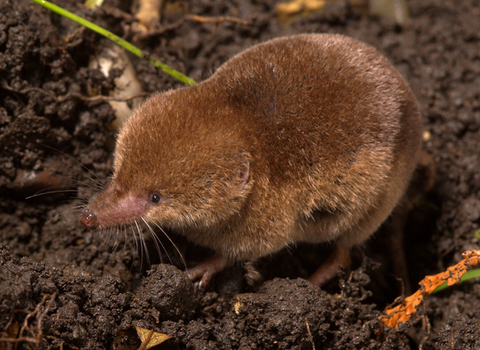
Common shrew ©Paul Adams
Common shrew
The diminutive common shrew has a distinctively pointy nose and tiny eyes. It lives life in the fast lane, eating every 2-3 hours to survive, and only living for a year or so. Look out for it in the garden.
Scientific name
Sorex araneusWhen to see
January to DecemberSpecies information
Category
Statistics
Length: 5-8cmTail: 2-4cm
Weight: 5-14g
Average lifespan: 1-2 years
Protected in the UK under the Wildlife and Countryside Act, 1981.
About
A small, insectivorous mammal, the common shrew has tiny eyes and a large nose giving it keen sense of smell. Shrews hectively snuffle through the undergrowth for their prey, which includes earthworms, spiders and insect chrysalises. They can be found in most habitats, but prefer woodland and grassland. Active by day and night, they are very territorial and aggressive for their size and can sometimes be heard fighting, their high-pitched squeaks particularly noticeable during the summer. Adults may only live for a year, just long enough to have three or four litters of around six young.How to identify
The common shrew has tiny eyes, very small ears and a pointy face with a long nose. It is dark brown above, grey or silver below, and has chestnut-coloured sides. It is larger than the pygmy shrew, but its tail is only half the length of its body (pygmy shrew tails are two-thirds the length of their bodies).Distribution
Widespread, but absent from the Channel Islands, the Isles of Scilly, Scottish islands, the Isle of Man and Northern Ireland.In our area
Join today
Join thousands of members who are already protecting Cumbria's wildlife & wild places. More about membership
Did you know?
The common shrew is always hungry: it needs to eat 80-90% of its body weight every day to survive. It mainly preys on insects, but will also eat slugs and snails, and will happily tackle earthworms as long as 10cm - bigger than its own body!Join today
Join thousands of members who are already protecting Cumbria's wildlife & wild places. More about membership
